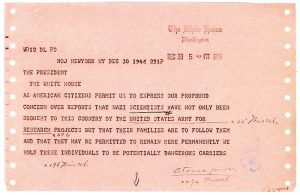Operation Sea-Spray was a 1950 U.S. Navy secret biological warfare experiment in which Serratia marcescens and Bacillus globigii bacteria were sprayed over the San Francisco Bay Area in California, in order to determine how vulnerable a city like San Francisco may be to a bioweapon attack.
Starting on September 20, 1950 and continuing until September 27, the U.S. Navy released the two types of bacteria from a ship off the shore of San Francisco, believing them to be harmless to humans. Based on results from monitoring equipment at 43 locations around the city, the Army determined that San Francisco had received enough of a dose for nearly all of the city’s 800,000 residents to inhale at least 5,000 of the particles.
Senate subcommittee hearings
In 1977, the U.S. Senate Subcommittee on Health and Scientific Research held a series of hearings at which the U.S. Army disclosed the existence of the tests. Army officials noted the pneumonia outbreak in their testimony but said any link to their experiments was totally coincidental. The Army pointed out that no other hospitals reported similar outbreaks and all 11 victims had urinary-tract infections following medical procedures, suggesting that the source of their infections lay inside the hospital.
Lawsuit
In 1981, Nevin’s surviving family members filed suit against the federal government, alleging negligence and responsibility for the death of Edward J. Nevin, as well as financial and emotional harm caused to Mr. Nevin’s wife from the medical costs.
The lower court ruled against them primarily because the bacteria used in the test was unproven to be responsible for Mr. Nevin’s death. The Nevin family appealed the suit all the way to the U.S. Supreme Court, which declined to overturn lower court judgments.
Similar biological warfare tests
In the Senate subcommittee hearings in 1977, the Army revealed:
Between 1949 and 1969, open-air tests of biological agents were conducted 239 times. In 80 of those experiments, the Army said it used live bacteria that its researchers at the time thought were harmless. In the others, it used inert chemicals to simulate bacteria.
In the 1950s, army researchers dispersed Serratia on Panama City and Key West Florida with no known illnesses resulting.
In the 1950s, army researchers dispersed zinc cadmium sulfide (now a known cancer-causing agent) over Minnesota and other Midwestern states to see how far they would spread in the atmosphere. The particles were detected more than 1,000 miles away in New York state.
Bacillus globigii, never shown to be harmful to people, was released in San Francisco, New York, Washington, D.C., and along the Pennsylvania Turnpike, among other places.
In New York, military researchers in 1966 spread Bacillus subtilis variant Niger, also believed to be harmless, in the subway system by dropping lightbulbs filled with the bacteria onto tracks in stations in midtown Manhattan. The bacteria were carried for miles throughout the subway system. Army officials concluded in a January 1968 report that: “Similar covert attacks with a pathogenic disease-causing agent during peak traffic periods could be expected to expose large numbers of people to infection and subsequent illness or death.”
In a May 1965 secret release of Bacillus globigii at Washington’s National Airport and its Greyhound Lines bus terminal, more than 130 passengers were exposed to the bacteria traveling to 39 cities in seven states in the two weeks following the mock attack.
Source: Wikipeadia: en.wikipedia.org/wiki/Operation_Sea-Spray

Further References
Jim Carlton,Of Microbes and Mock Attacks: Years Ago, The Military Sprayed Germs on U.S. Cities, The Wall Street Journal. URL: www.wsj.com/articles/SB1003703226697496080Bentley, Michelle. “The US has a history of testing biological weapons on the public – were infected ticks used too?”. The Conversation. URL: theconversation.com/the-us-has-a-history-of-testing-biological-weapons-on-the-public-were-infected-ticks-used-too-120638




![Rockefeller Report (1994) e835b00c2df6013ecd0b4401ef444f94eb6ae3d01db3164094f0c971_640[1]](https://cognitive-liberty.online/wp-content/uploads/e835b00c2df6013ecd0b4401ef444f94eb6ae3d01db3164094f0c971_6401-300x220.jpg)
![Operation Northwoods ee30b10b2fe91c72d15e4c0def4e4e8be272e6d118b5184793f4_640[1]](https://cognitive-liberty.online/wp-content/uploads/ee30b10b2fe91c72d15e4c0def4e4e8be272e6d118b5184793f4_6401-300x158.jpg)
![Toxic Chemical Geoengineering in the Troposphere: Consequences for Public Health Screenshot 2021-07-04 at 23-12-54 Evidence of Coal-Fly-Ash Toxic Chemical Geoengineering in the Troposphere Consequences fo[…]](https://cognitive-liberty.online/wp-content/uploads/Screenshot-2021-07-04-at-23-12-54-Evidence-of-Coal-Fly-Ash-Toxic-Chemical-Geoengineering-in-the-Troposphere-Consequences-fo...-300x223.png)

